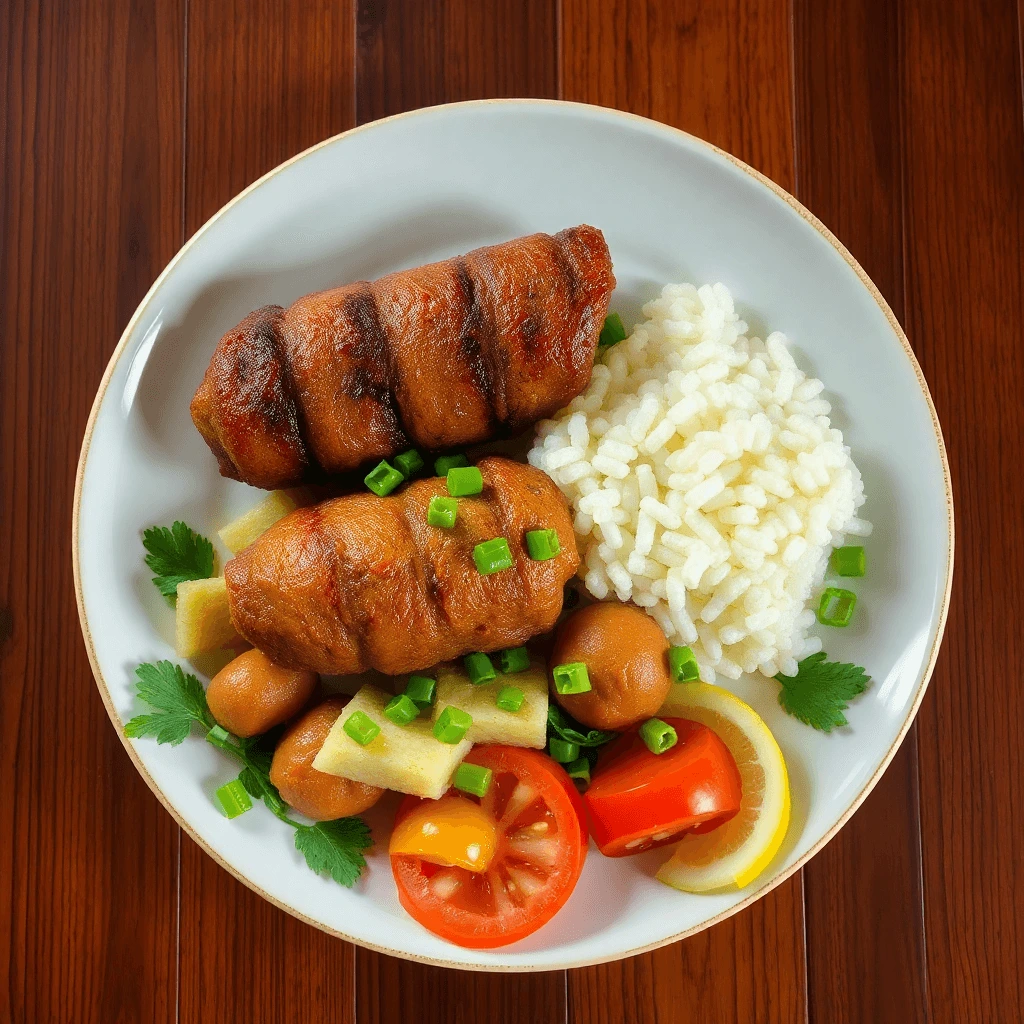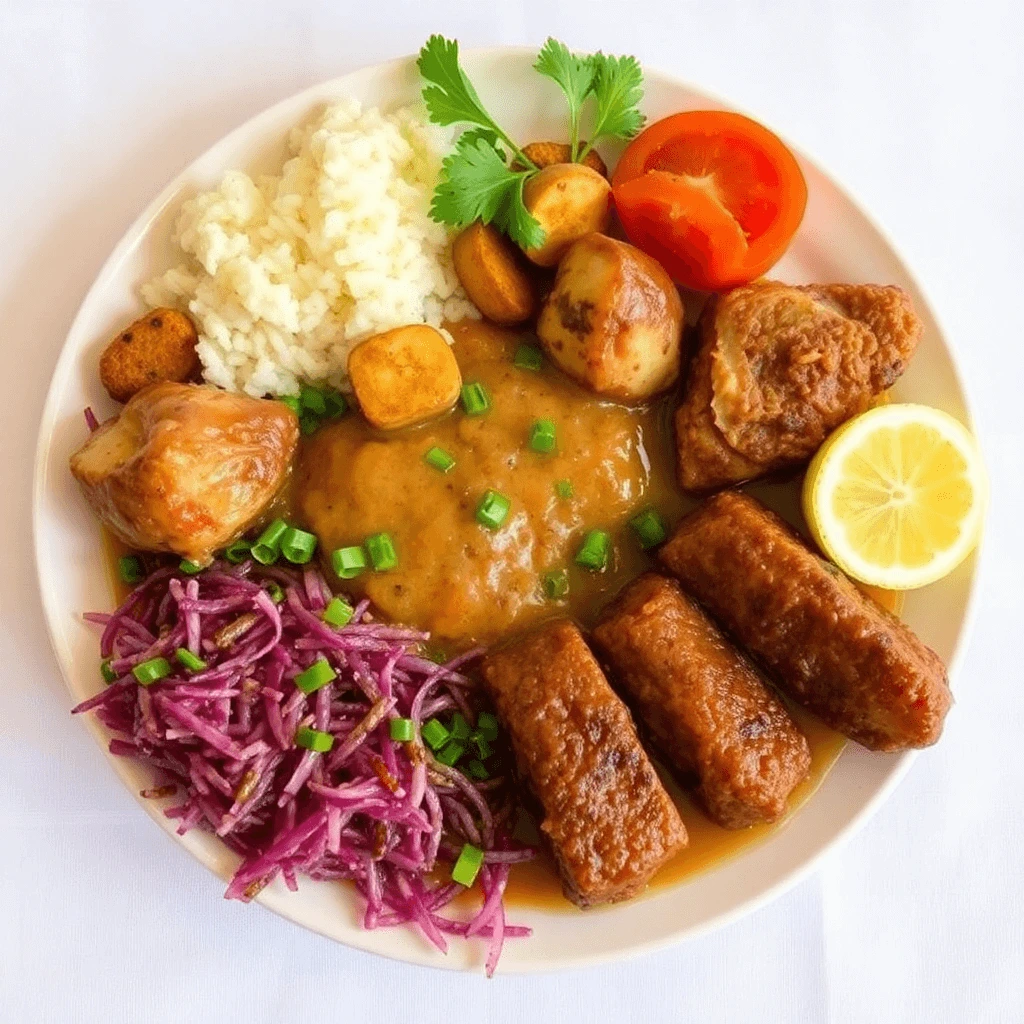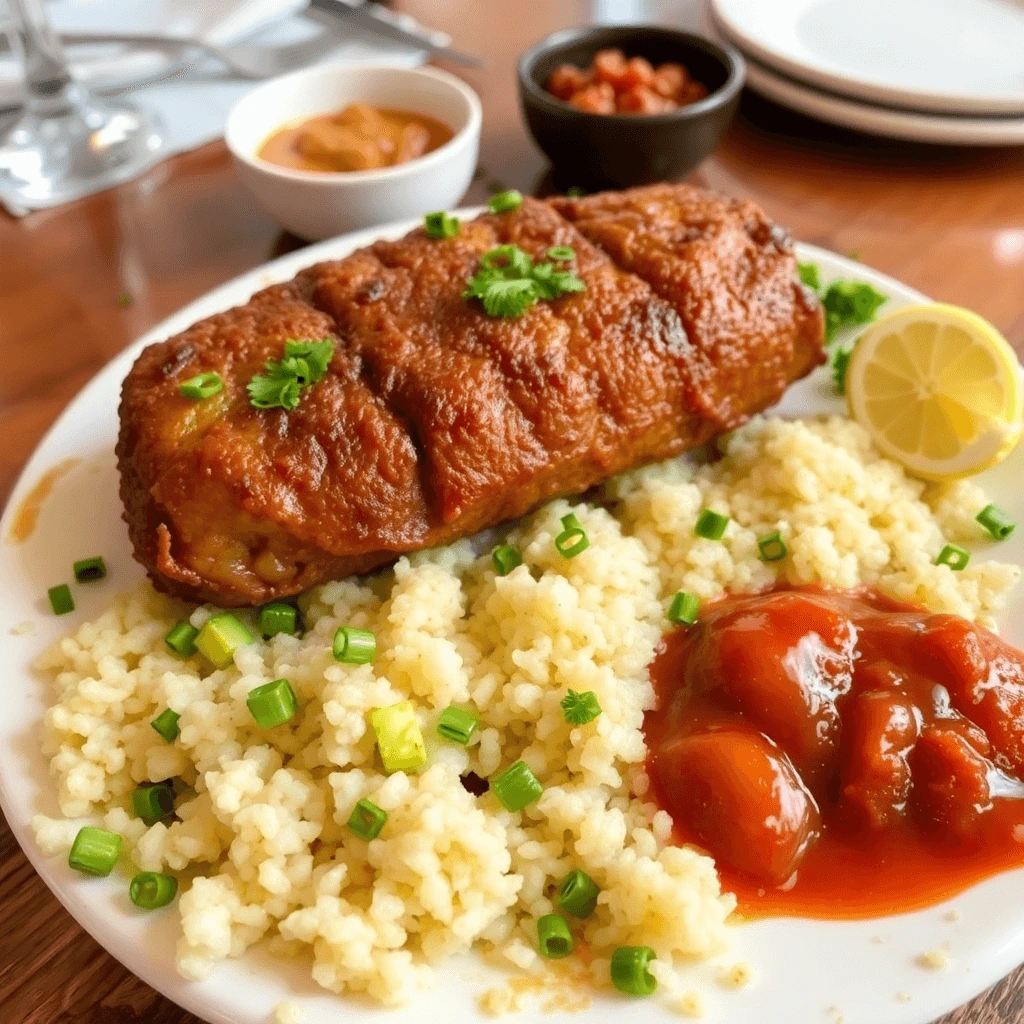If you’re looking for the best Iraqi meal for dinner, Halaby Kibbeh is a must-try dish. This crispy, golden-fried delicacy is a staple in Iraqi and Middle Eastern cuisine, known for its rich flavors and satisfying texture. Made with bulgur wheat, spiced ground lamb, and crunchy pine nuts, Halaby Kibbeh offers the perfect balance of crunchy, savory, and aromatic goodness.
In this blog post, we’ll walk you through an authentic Halaby Kibbeh recipe, from preparing the flavorful filling to shaping and frying the kibbeh to perfection. Whether you’re new to Iraqi cuisine or a long-time fan, this dish is guaranteed to impress at the dinner table. Let’s dive in!


What Is Halaby Kibbeh?
Cultural and Historical Context:
- Iraqi Cuisine – TasteAtlas – Overview of traditional Iraqi dishes.
- History of Kibbeh – The Spruce Eats – Details on different kibbeh variations.
Halaby kibbeh is a traditional Middle Eastern dish that hails from Aleppo, Syria, known for its rich culinary heritage. This dish is a beloved staple in Syrian cuisine and is recognized for its unique flavors, textures, and cultural significance.
Halaby kibbeh is characterized by its use of finely ground meat, typically lamb or beef, combined with bulgur wheat, onion, and a blend of aromatic spices such as cinnamon, allspice, and nutmeg. This mixture forms a dough that serves as both the outer shell and filling of the kibbeh. The inclusion of spices not only enhances the taste but also reflects the historical trade routes of the region, showcasing the influence of various cultures on Syrian cooking.
Unlike some other variations of kibbeh, Halaby kibbeh typically features a distinct layer of thinly sliced meat or an aromatic filling, often made with sautéed onions, pine nuts, and more spices, which adds an extra dimension of flavor. The kibbeh can be prepared in several ways: it can be shaped into balls or patties, deep-fried for a crispy texture, baked in a tray, or served raw, showcasing its versatility.
In Aleppo, kibbeh is considered a ceremonial dish, often served during festive occasions, family gatherings, or holidays, symbolizing hospitality and culinary tradition. It is usually accompanied by side dishes such as yogurt, fresh salad, and pita bread, making it a wholesome and satisfying meal for sharing with loved ones.
Overall, Halaby kibbeh represents not just a dish, but a vibrant cultural experience, offering a taste of the rich history and traditions of Middle Eastern cuisine. Whether enjoyed at a family gathering or a special celebration, Halaby kibbeh is a beloved dish that captures the essence of communal dining and the joy of sharing food with others.
Ingredients You’ll Need for Authentic Halaby Kibbeh
To prepare authentic Halaby kibbeh, you will need the following ingredients, which can be categorized into the kibbeh dough, the filling, and additional components for frying and serving.
For the Kibbeh Dough:
- 1 pound of finely ground meat: Traditionally, lamb is used, but you can also use beef or a combination of the two. The key is to ensure the meat is ground very fine to achieve the desired texture.
- 1 cup of fine bulgur wheat (#1): Bulgur is a staple in Middle Eastern cuisine and provides the kibbeh with its characteristic texture. Make sure to use the fine grade for this recipe.
- 1 medium onion, finely chopped: The onion should be chopped to a point where it’s almost paste-like to distribute evenly throughout the dough.
- 1 teaspoon of ground cinnamon: Adds warmth and depth to the kibbeh.
- 1/2 teaspoon of ground allspice: Contributes a unique blend of spices, including cinnamon, nutmeg, and cloves, which is typical in Middle Eastern baking.
- 1/2 teaspoon of ground cumin: Enhances the aroma and adds an earthy flavor.
- 1/2 teaspoon of salt: Balances the flavors.
- 1/4 teaspoon of black pepper: Adds a slight kick.
- 1/4 teaspoon of cayenne pepper (optional): For those who prefer a bit of heat.
For the Filling:
- 1/2 pound of finely ground meat: Same as used for the dough, but kept separate.
- 1/4 cup of finely chopped onion: Cooked until it’s translucent and slightly caramelized.
- 1/4 cup of pine nuts: Toasted to bring out their flavor and aroma.
- 1 tablespoon of olive oil: Used to sauté the onions and pine nuts.
- 1 teaspoon of salt: To taste.
- 1/2 teaspoon of black pepper: To taste.
- 1/4 teaspoon of ground allspice: Adds depth to the filling.
Additional Ingredients:
- Breadcrumbs or semolina flour for coating: Helps achieve a crispy exterior when frying.
- Vegetable oil for frying: Preferably something with a high smoke point like canola or grapeseed oil.
- Fresh parsley, chopped (for garnish): Adds a pop of color and freshness.
- Yogurt or tahini sauce (for serving): Provides a cooling contrast to the crispy, savory kibbeh.
Notes on Ingredients:
- Freshness and Quality: The quality of your ingredients, especially the meat and bulgur, can significantly impact the final taste and texture of your kibbeh.
- Adjusting Spices: Feel free to adjust the amount of spices according to your personal taste preferences. Some people prefer a stronger cinnamon flavor, while others like it more subtle.
- Using the Right Bulgur: Fine bulgur is essential for the kibbeh dough as it helps in achieving the right consistency. Coarser bulgur is better suited for other dishes like tabbouleh.
By carefully selecting and preparing these ingredients, you’ll be well on your way to creating authentic Halaby kibbeh that’s both delicious and true to its Middle Eastern roots.
Step-by-Step Guide to Making Halaby Kibbeh
Step 1: Prepare the Kibbeh Dough
- Grind the Meat: Start by grinding the lamb or beef into a fine paste using a meat grinder or a food processor. Ensure it’s very fine, almost like a paste, for the best results.
- Mix with Bulgur and Onion: In a large bowl, combine the ground meat, bulgur, and chopped onion. Mix well until everything is fully incorporated.
- Add Spices and Seasonings: Add the cinnamon, allspice, cumin, salt, black pepper, and cayenne pepper (if using) to the mixture. Mix everything until the spices are evenly distributed throughout the meat mixture.
- Knead the Dough: Knead the mixture with your hands until it forms a dough. Be careful not to overwork it, as this can make the kibbeh dense.
- Rest the Dough: Place the dough in a clean bowl and let it rest at room temperature for about 30 minutes. This allows the flavors to meld together.
Step 2: Prepare the Filling
- Grind Additional Meat: Grind another half pound of meat into a fine paste just like in step 1.
- Sauté the Onion and Pine Nuts: In a pan, heat a tablespoon of olive oil over medium heat. Add the chopped onion and sauté until it’s translucent and slightly caramelized. Then, add the toasted pine nuts and sauté for another minute.
- Season the Filling: Add salt, black pepper, and a pinch of allspice to the onion and pine nut mixture. Stir well to combine.
Step 3: Shape the Kibbeh
- Divide the Dough: Divide the dough into small portions, about the size of a small egg. You can also shape them into small squares or balls.
- Make a Well: Flatten each portion of dough slightly into a disc shape, making a well in the center.
- Add Filling: Place a small amount of the filling mixture in the center of each dough disc.
- Close and Seal: Fold the dough over the filling and press the edges together to seal the kibbeh.
Step 4: Fry or Bake the Kibbeh
- Dredge in Breadcrumbs or Semolina: Roll each kibbeh in breadcrumbs or semolina flour to coat evenly.
- Fry: Heat about an inch (2.5 cm) of vegetable oil in a deep frying pan over medium heat. Fry the kibbeh until golden brown on both sides.
- Bake: Alternatively, preheat your oven to 375°F (190°C). Place the kibbeh on a baking sheet lined with parchment paper and bake for about 20-25 minutes, or until golden brown.
Step 5: Serve
- Garnish with Parsley: Sprinkle chopped parsley on top of each kibbeh for a fresh touch.
- Serve with Yogurt or Tahini Sauce: Serve the kibbeh with yogurt or tahini sauce for a cooling contrast to the crispy kibbeh.
By following these steps carefully, you’ll be able to create delicious Halaby kibbeh that’s both crispy on the outside and tender on the inside, perfect for any meal or gathering.
Serving Suggestions: What to Eat with Halaby Kibbeh?
Halaby kibbeh is a delightful, flavor-packed dish that can be enjoyed in various ways. Here are some serving suggestions that will enhance your meal and complement the rich flavors of the kibbeh:
1. Traditional Accompaniments
- Yogurt Sauce: A simple, tangy yogurt sauce can elevate your kibbeh experience. You can mix plain yogurt with minced garlic, a sprinkle of salt, and a drizzle of olive oil. Garnish it with fresh herbs like mint or parsley for extra flavor.
- Tahini Sauce: A creamy tahini dressing, made from tahini, lemon juice, garlic, and water, adds a nutty depth when drizzled over kibbeh. This combination is especially refreshing and complements the spices in the kibbeh beautifully.
2. Salads
- Fattoush: This traditional Lebanese salad made from mixed greens, radishes, tomatoes, and crispy pita chips brings a wonderful crunch and a tangy flavor with its sumac dressing, creating a perfect balance with kibbeh.
- Tabbouleh: A refreshing dish that is primarily made of parsley, tomatoes, bulgur, and mint, all dressed with olive oil and lemon juice. Its zesty profile complements the richness of kibbeh.
- Cucumber and Tomato Salad: A quick salad of diced cucumbers and tomatoes, dressed in olive oil and lemon juice, provides a fresh, crunchy contrast to the hearty kibbeh.
3. Grains and Sides
- Rice Pilaf: Serve your kibbeh with a fragrant rice pilaf, which can be made with or without nuts and raisins. The fluffy rice is excellent for soaking up any juices and sauces.
- Stuffed Grape Leaves: Known as “Warak Enab,” these can serve as another Middle Eastern specialty alongside kibbeh. The tangy and savory flavors balance well on the plate.
4. Breads
- Pita Bread: Soft, warm pita is perfect for scooping up kibbeh or the accompanying sauces. You can also serve it stuffed with kibbeh, along with fresh vegetables.
- Laban (Yogurt) Bread: If you want something more unique, laban bread—a yogurt-rich flatbread—provides a slight tang and complements the rich textures of kibbeh.
5. Vegetables
- Roasted Vegetables: Roasted seasonal vegetables seasoned with olive oil, garlic, and herbs serve as an excellent addition to highlight the kibbeh. Try eggplant, zucchini, and bell peppers, which can add color and nutrition to your meal.
- Pickles: Middle Eastern pickles offer a sharp contrast to the rich flavors of kibbeh. Serve a variety of pickled vegetables, such as turnips, pickled cucumbers, or olives, to stimulate the palate.
6. Beverages
- Mint Tea: A refreshing glass of mint tea, hot or iced, provides a fragrant and light accompaniment, cleansing the palate between bites.
- Pomegranate Juice: This sweet and tart drink is not only refreshing but also pairs exceptionally well with Middle Eastern dishes.
7. Presentation
- Plating: Make sure to arrange the kibbeh attractively on a serving platter. You can place them next to the dips and salads, allowing guests to customize their bites.
- Garnishes: Use fresh herbs like parsley, mint, or dill to garnish the meal. You can also sprinkle pomegranate seeds for an extra touch of color and a burst of flavor.
Final Thoughts
Whether you choose to serve Halaby kibbeh with classic Middle Eastern sides or modern interpretations, these suggestions ensure a well-rounded meal that highlights the flavors and textures of this beloved dish. The interplay between the crispy, savory kibbeh and the vibrant, fresh sides creates a memorable dining experience. Enjoy your meal!
Tips for Perfect Halaby Kibbeh Every Time
Making Halaby kibbeh can be a bit tricky, but with some expert tips and tricks, you can achieve a perfect dish every time. Here are some invaluable tips to elevate your Halaby kibbeh:
1. Choosing the Right Meat: Selecting the right meat is crucial for the flavor and texture of your kibbeh. Use a mix of ground lamb and beef for a classic flavor, but feel free to experiment with other meats, such as goat or buffalo.
2. Don’t Overwork the Dough: Mix the meat and spices just until they’re combined, and avoid overworking the dough, as this can make the kibbeh dense and tough.
3. Use the Right Bulgur: Choose fine or medium bulgur, as it’s easier to mix and shape into small pieces. Fine bulgur can make the kibbeh too dense, while coarse bulgur might make it too dry.
4. Rest the Dough: Letting the dough rest allows the flavors to meld together and the bulgur to absorb the moisture. This step is crucial in creating a tender and well-flavored kibbeh.
5. Chill the Dough: Refrigerating the dough for at least 30 minutes helps to firm it up and makes it easier to shape. This step prevents the kibbeh from falling apart when cooked.
6. Frying Temperature: Frying the kibbeh at the right temperature is crucial. Heat the oil to around 350°F (175°C) for golden-brown kibbeh. Use a thermometer to ensure the correct temperature.
7. Breading the Kibbeh: Use a light dusting of breadcrumbs or all-purpose flour to prevent the kibbeh from becoming too heavy. This step also helps the kibbeh crisp up evenly.
8. Don’t Overcook: Fry or bake the kibbeh until it’s golden brown, but avoid overcooking. This can make the kibbeh dry and crumbly.
9. Experiment with Spices: Traditional Halaby kibbeh spices include cinnamon, allspice, and black pepper. Feel free to experiment with other spices, such as cumin, coriander, or paprika, to create your unique flavor.
10. Practice Makes Perfect: Making Halaby kibbeh takes practice, so don’t be discouraged if your first batch doesn’t turn out perfectly. Experiment with different ingredients and techniques to achieve your ideal kibbeh.
Bonus Tips:
- Freeze the Dough: If you’re not planning to serve the kibbeh immediately, you can freeze the dough for up to 3 months. Simply thaw it when you’re ready to cook.
- Bake the Kibbeh: If you prefer to bake the kibbeh, preheat your oven to 375°F (190°C). Place the kibbeh on a baking sheet lined with parchment paper and bake for about 20-25 minutes, or until golden brown.
- Use a Meat Grinder: Grinding the meat with a food processor or meat grinder ensures a fine texture and even distribution of spices.
- Keep it Fresh: Store leftover kibbeh in an airtight container in the refrigerator for up to 3 days or freeze for up to 3 months.
Halaby Kibbeh Troubleshooting Guide
Sometimes, kibbeh can turn out wrong due to various reasons. Here’s a quick guide to troubleshoot common issues:
- Dense Kibbeh: Check if you overmixed the dough or didn’t rest it long enough.
- Dry Kibbeh: Ensure you’re using enough fat (meat fat or olive oil) and not frying at too high a temperature.
- Kibbeh Falls Apart: Make sure to chill the dough and coat the kibbeh lightly with breadcrumbs before frying.
Halaby Kibbeh Variations
While traditional Halaby kibbeh is a classic, feel free to experiment with different variations:
- Veggie Kibbeh: Use finely chopped vegetables, such as onions, carrots, and zucchini, instead of meat for a vegetarian option.
- Seafood Kibbeh: Mix in some grated fish or shrimp for a seafood twist.
- Mushroom Kibbeh: Sautéed mushrooms add a rich, earthy flavor to this variation.
By following these expert tips and tricks, you’ll be well on your way to making the perfect Halaby kibbeh every time. Practice, experiment, and enjoy the process of creating this beloved Middle Eastern dish!

